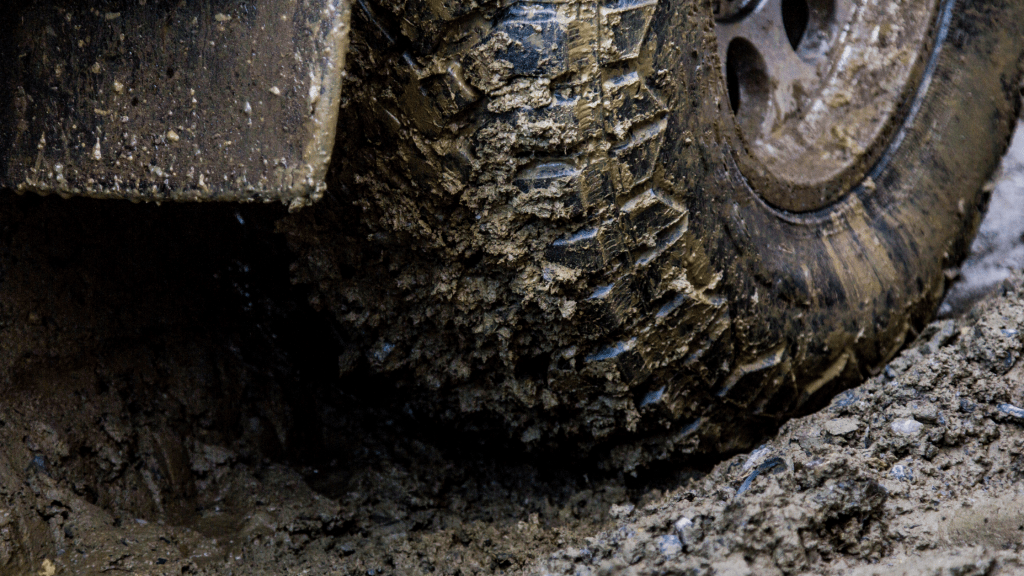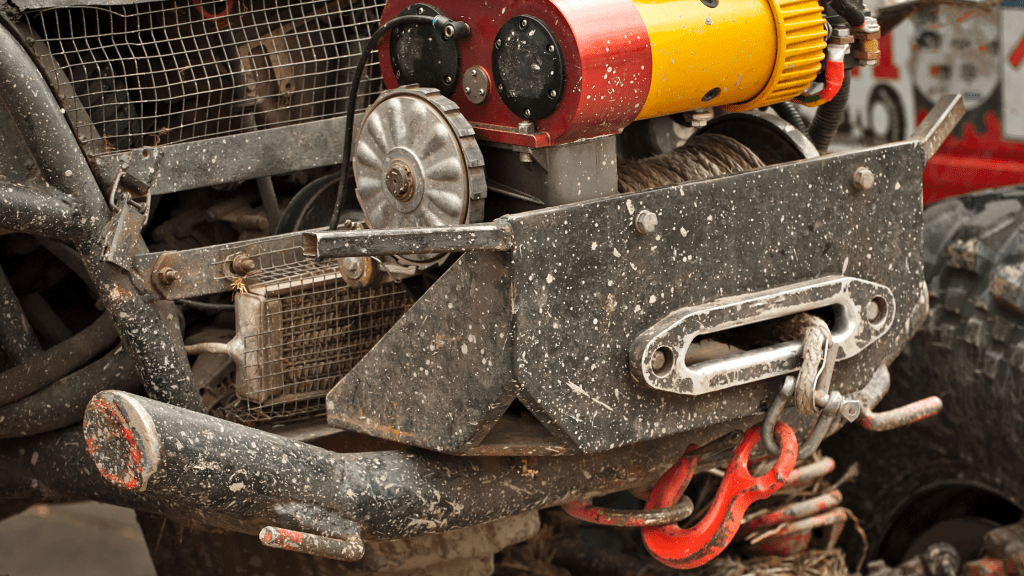There’s something therapeutic about Overlanding, the ability to seek out new places, new adventures, to get the most remote places imaginable.
But what happens when you get stuck in that remote place? Suddenly it’s not as therapeutic as it once was.
Anyone that considers themselves an off-roader or overlander would be wise to carry a fully equipped off-road recovery kit.
Here we look at what we consider to be some of the best kits available today.
Top 5 Recovery Kits
- Rhino USA – recovery kit
- WARN 97565 Medium-Duty Epic recovery kit
- Gear America – recovery kit
- ALL-TOP Nylon Heavy Duty – recovery kit
- ARB RK9 Premium Recovery Kit
Recovery Kits
Rhino USA – Recovery Kit
We won’t lie to you; we absolutely love the color of the Rhino USA off-road Recovery Kit. A lot of the other recovery kits that you find on this page are a rather bland orange.
Granted, orange is a fantastic color for safety, but so is the brilliant green color that Rhino USA products are laden with.
It doesn’t really have that much of an impact on the quality of the kit (which is brilliant!), but we do love our car accessories to be pleasing to the eye.
The 20-foot recovery strap in this kit has been rated up to exactly 31,518lbs; this goes to show just how much testing it has undergone.
Rhino USA knows exactly which vehicles you are going to be pulling out of their predicament with this strap.
To go with your 20-foot recovery strap, you have 2 x D-Ring shackles. They are incredibly durable and have been rated up to 41,850lbs. All are stored in a cool little Rhino USA bag.
That’s about it. We know that this is not the most extensive recovery kit in the world. Many of the others on this page are going to come with tree savers, some with snatch boxes, and some with gloves.
However, we are going to let you in on a little secret here. Most people don’t need all of those extras. 95% of recovery efforts are going to be completed using a simple recovery strap.
WARN 97565 Medium-Duty Recovery Kit
This recovery kit from WARN doesn’t have the highest weight rating in the world. However, if you have a light to medium weight vehicle, you don’t need that. You want something capable of getting the job done without breaking the bank. The WARM Medium-Duty Recovery Kit offers that.
The premium recovery strap is 2″ wide and 30-feet in length. It is capable of tugging up to 14,000lbs. Again, not the highest on this list, but we are sure that it is going to be suitable for the vast majority of smaller off-road vehicles.
The shackles are capable of handling up to 18,000lbs. These are some of the most solidly built shackles we have seen. Well, at least at this price point. This is perfect for connecting up to your winches.
Rounding out the kit, you have a tree protector (2″ wide, 8-feet in length, 14,000lbs weight capacity), and a snatch block for weights up to 12,000lbs.
All of this comes packed into a backpack which makes transportation of your recovery kit dead simple.
Gear America – Recovery Kit
If you want something affordable but durable, then you may want to pay attention to the Gear America Recovery Kit.
At the heart of this kit is a 3″ wide, 20-foot long tow strap. it can withstand up to 35,000lbs of weight.
Unlike many of the other tow straps in the ‘budget’ category, this bit of kit could easily last several recovery efforts. Although, one would hope that you never actually have to do that.
To match up with your tow strap, you have 2 D-Ring Shackles that can cope with up to 58,000lbs in weight. Basically, you don’t have to worry about these ever breaking on you.
No matter what conditions you are using your recovery cut in, you can be sure that the D-Ring Shackles are going to be able to cope with whatever you throw at them.
Rounding out the kit, you have an 8-foot tree saver (also rated up to 35,000lbs), 9-ton snatch block, winch line dampener, and even a pair of heavy-duty gloves. All of this loads into a custom bag designed to keep your recovery kit handy whenever you need it.
When used in normal conditions, this recovery kit comes with a Lifetime Warranty too.
It just gives you a bit of extra peace of mind. Although, do bear in mind that your tow straps can only be used for a few recovery efforts.
That applies to all tow straps (Not just these). The warranty won’t cover the stretching that will inevitably happen.
ALL-TOP Nylon Heavy Duty – Recovery Kit
Don’t let the price deceive you; this recovery kit from ALL-TOP packs a real punch in the quality department. Sure, it probably isn’t going to be anywhere near as brilliant as some of the ‘top of the line’ recovery kits.
It isn’t really recommended for people that are doing some serious off-roading. However, for those that want to load a recovery kit into their vehicle ‘just in case’, then this would be perfect.
Even if you only ever use it once or twice, it is still going to be getting the job done.
There is only one included strap inside this recovery kit. This is coupled with 2pc 3/4 Forged Shackles. There are a variety of different kits available, though.
Each kit contains a strap of a different length. You have 20-feet, 30-feet, and 8-feet options. The strap is always 3″ wide, which is more than enough for the vast majority of vehicle recovery efforts.
As we said before, the strap that you get included in this kit is ridiculously durable too. No matter what length you buy, the strap can cope with up to 36,000lbs. Again, this makes it fantastic for the vast majority of recovery efforts.
This is a must-buy for those that know that they need a recovery kit but do not want to spend huge sums of cash on one.
ARB RK9 Premium Recovery Kit
The ARB RK9 Premium Recovery Kit is a massive box packed to the brim with all sorts of accessories to make vehicle recovery simple.
Inside the box, you can look forward to a 17,600lbs snatch strap, 9,900lbs winch extensive strap, 26,000lbs tree trunk protector, a couple of bow shackles, a 19,800lbs snatch block, and a whole lot more.
All of this is neatly stored inside a durable bag. This way you can be sure that it is protected while you are out there on the trails.
While we know that this kit is way more expensive than similar options on the market, we cannot stress enough just how high-quality all of the accessories are.
Now, hopefully, you will never have to use it. Nobody really wants to be using a recovery kit. However, the second you lay your hands on the ARB RK9 Premium Recovery Kit, you will know that it is more than ready just in case. Anything you want to throw at it, it will easily be able to handle.
What’s in a recovery kit
A basic recovery kit like the ones mentioned above is the bare minimum needed for off-road recovery. These kits include:
D Shackles
D shackles are used for secure recovery points on the stuck vehicle. It’s not recommended to attach a recovery rope to any part of the vehicle, so a shackle is secured to the heavy-duty bumpers.
Snatch Block
A snatch block is primarily used for two purposes: 1) Increase the pulling capacity of your winch and 2) To redirect your winching angle.
Snatch blocks help you to get of complicated situations like if there was no tree to winch off directly in front of you.
Snatch Strap
It’s important to note here that a snatch strap and a recovery strap are not the same things. A snatch strap is more akin to a kinetic rope.
The snatch strap allows the vehicle recovering you to get a bit of a run before reaching full extension from the strap. This is possible due to the kinetic energy of the rope that makes it “stretchy”.
Tree Saver
Tree savers or tree protectors are what they sound like. They are straps to go around any given tree you wish to winch off. The benefit of tree savers are twofold; not only do they protect the tree, but they give you more flexibility when winching.
Another benefit of tree trunk protectors is that they can half the load of a recovery point. They do this by connecting each end of the strap to a different rescue point of the vehicle and then connecting the rescue strap to the center of the tree saver.
Line Dampener
Winching is a hazardous activity, especially when using a steel cable winch. These types of winches store kinetic energy, and when put under pressure they can become extremely dangerous if they snap.
To counter the kinetic energy, a device known as a line dampener or winch dampener is used. Putting a dampener on the cable or rope when winching would send the cable to the ground and out of harm’s way if it were to snap.
Recovery Strap
You may already be familiar with recovery straps from towing other vehicles, or maybe you have been towed yourself. But what you may not know is that they also make a great extension to your winch rope.
We strongly recommend you add other items to this list. Things we recommend adding:
- Off-Road Shovel
- Off-Road Jack
- Tire Deflators
- Recovery Boards
- Soft Shackle
How to use an off-road recovery kit

So, now you know about some of the best recovery kits on the market, how do you actually use one? Well, it is surprisingly simple! Your recovery kit will often be loaded up with accessories.
However, truth be told, you will only need to use a couple of accessories for the vast majority of recovery efforts. That is what we want to talk about here; dealing with most off-road vehicle recoveries.
If you have multiple straps inside your recovery kit, the one you want to be on the lookout for is the snatch strap. It should be labeled. However, if it isn’t, it is generally the longest strap in that kit. It also has a little bit of elasticity to it.
Step 1: Connect the Strap to the Stranded Vehicle
Your first job is to attach your snatch strap to the stranded vehicle. You are going to need your shackles and snatch strap for this.
You must work out where the ‘recovery points’ on the vehicle are. These are the points where you can attach the recovery strap. All vehicles should have two rated recovery points on the front of the vehicle and two on the rear of the vehicle.
If you do not know where the rated recovery points are, please check the manual for your vehicle.
It is important that you only use rated recovery points here. If you don’t, then it is dangerous. The pulling force of the recovery could send chunks of metal flying as they are ripped off of your vehicle. Don’t let this happen.
Once you have found your rated recovery points, it is time to get hooked up.
Remove the pin from one of the shackles. Pass it through the eyelet at one end of the snatch strap.
Now you need to line the shackle up with the recovery point. When the holes are aligned, put the pin through and make sure that everything is tightened up securely.
It is important to note that shackles can work slightly differently between recovery kit manufacturers. Make sure that you read the recovery kit manual so you know how to connect everything up.
Step 2: Attach the Strap to the Recovery Vehicle
You now need to repeat the same process with the recovery vehicle, albeit with one small change.
The recovery vehicle should be close enough to the stranded vehicle to leave a couple of meters of slack in the snatch strap. Basically, that strap should not be pulled tight at all. There should be enough slack that the snatch strap can rest comfortably on the ground.
Step 3: Attach the Strap Damper
Inside your recovery kit should be a strap damper. This should be placed over the center of the strap.
If you do not have a strap damper, then we recommended that you buy one. Alternatively, you can place a heavy blanket over the strap.
The purpose of the strap damper is to help protect you and your vehicles should the snatch strap snap during the recovery process.
Step 4: Preparing the Stranded Vehicle for Recovery
There needs to be a driver in the stranded vehicle.
The stranded vehicle needs to be switched to first gear. The engine should also be running.
The driver must have both hands on the wheel as the stranded vehicle can slide about a lot during the recovery process.
Step 5: Preparing the Recovery Vehicle
The recovery vehicle driver needs to switch their vehicle to 2nd gear. The engine should still be running, and the driver needs to know where they are heading. It should, preferably, be straight.
Step 6: Recovery
The final stage is the recovery process.
If you can, try to back the recovery vehicle up so that it is around a car length away from the vehicle it is recovering. This just allows the vehicle to put a bit more momentum into the strap.
If you can’t, it doesn’t matter too much. As long as you have a good 6-8 feet slack in the strap, then you should be fine. It just may take a few attempts to recover the vehicle.
The key to good recovery is communication. It is important that the driver in the recovery vehicle can communicate with the stranded vehicle.
This should, preferably, be over the radio so nothing is lost in translation. Most people off-road with some sort of radio communication gear, so this shouldn’t be a problem.
As soon as the recovery vehicle is ready to pull, they should tell the driver. The recovery vehicle will then accelerate in a slow, controlled manner i.e. you shouldn’t be pushing that pedal straight into the floor. Gradually build up speed.
As the recovery vehicle accelerates, it will move forward. This will tighten up the strap. When that strap is fully tightened, the stranded vehicle driver needs to accelerate too.
In most cases, one good attempt is all that is required to pull a stranded vehicle. If the vehicle is a bit more bedded in, then repeat the process. The vehicle should (hopefully) move a small amount each time. It won’t be long before it is completely free!
- Tips and tricks For Setting Up Camp Like a Pro - September 11, 2023
- The Best Multi-Tools for Overlanding Adventures - August 25, 2023
- Off-Road Navigation Tips for Overlanders - August 13, 2023



